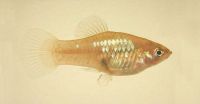Platy (Xiphophorus maculatus)
From The Aquarium Wiki
(Redirected from Red Tuxedo Platy)
Platy
Xiphophorus maculatus
45 Litres (12 US G.)
5.1-7.1cm (2-2.8 ")
Freshwater
7.0 - 8.0
22.2-26.7°C (72 -80 °F)
7-20 °d
1:3 M:F
3-5 years
Family
Poeciliidae
This animal is available captive bred
Contents
Additional names
- Platy, Moonfish, Southern Platyfish
Origin[edit]
- These little fish come from the east coast of Central America and Southern Mexico.
Sexing[edit]
- Females have a fan-shaped anal fin, wide bellies, a dark gravid spot, and are larger than the males. Males have a modified, rod-like anal fin, called a gonopodium.
Breeding[edit]
- Platies are one of the easiest fish to breed. As long as there is a male and a female, you are almost certain of eventually having fry. It is recomended you have 2 females for every male, as one male will put stress on a single female. Platies are livebearers, and the babies are born fully formed and ready to swim. They are capable of eating very shortly after birth. The female will sometimes eat her young so provide spawning grass, fine leaved plants, or put the newly born fry in a breeding trap (never put a pregnant female into a breeding trap as this will cause undue stress and possibly cause her to abort the fry). Young platies can be raised on baby brine shrimp or even finely crushed flake foods. They grow rapidly if the water quality is kept immaculate.
- Platys can hybridise with Swordtails.
Fish Size[edit]
Platies can grow longer than 6.4 cm, but they can grow to 7.0 cm (2.8 in).
Tank compatibility[edit]
- Platies are peaceful active livebearers that do well in an active peaceful community tank. They can be kept with other livebearers, but it's important to keep Platys in the ratio of 1 male per 2-3 females. Males will pursue other female livebearers and this constant hassle can stress fish. Furthermore the alpha male will pursue other platy males. In small tanks or tanks without much hiding places this is on the long-term life-threatening for the weakest male. Especially if there is only one other male beside the alpha male, suffering lonely from all aggressions.
Diet[edit]
- Platies are undemanding, thriving on typical community flake diets. Platies will also graze on algae growing in the tank or on tender plants. Treats like blood worms, glass worms, daphnia, brine shrimp,and woodlice are all eagerly accepted. Gather woodlice and dry them in the sun or in the oven for a nutritious snack. Break them into five or six pieces. If your tank has no plants or algae at all, offer a spirulina based food a few times a week. It is easiest to raise young platies in planted tanks where there is some algae to graze. They also like to eat some vegetables like courgette, cucumber or lettuce. Nuke them in a microwave for a little over 30 seconds on full power and then put them in the tank weighed down by plant clips.
Feeding regime[edit]
- When caring for platy fish, it's essential to provide them with a balanced and varied diet for optimal health and color vibrancy. A mix of high-quality flake foods should form the basis of their diet. Complement this with occasional live or frozen foods, such as bloodworms or brine shrimp, to provide a range of nutrients. Vegetables like zucchini or lettuce are also beneficial, adding vitamins and minerals to their diet. Feeding should be done twice a day, with portions they can consume in three minutes to prevent overfeeding and maintain a clean tank environment.
Environment specifics[edit]
- Platies are rather sensitive to ammonia, and should only be added to established tanks. Many beginners make the mistake of buying platies to cycle tanks and lose the fish to ammonia toxicity. As long as the water is clean, platies can tolerate a wide range of water conditions. They are at their best in moderately hard, slightly alkaline water.
Behaviour[edit]
- Platies are very gentle community fish. As with other livebearers, males tend to chase the females a bit. Try to maintain a ratio of two females for each male.
- Platies eagerly accept food from all levels of the tank. Their slightly upturned mouths give them a preference for top feeding, but they are quite capable of catching food in mid-water or picking it up from the substrate.
Identification[edit]
- Due to selective breeding this fish is widely available in many colours including shades of red, yellow, orange, blue, and black predominating. Young Platys can be mistaken for young Mollies and their body shapes are very similar.
- There is a morph named the Balloon Platy which is a mutation of the regular Platy. They have a shorter stunted body which makes them appear more rounded, like a balloon. This stunting can lead to them being prone to swim bladder problems. It is often recommended to not purchase these fish, as to discourage the continued breeding of deformed and stunted Platies.
- Hybrid forms are common in the pet trade. Our article on Platy Colours contains a listings of the various hybrid colour variations commonly available.
Pictures[edit]
Videos[edit]
| Hi-Fin Wagtail Sunset Platys: | Mixed Platys: |
External links[edit]
- Fishbase (Mirrors:
 )
)



